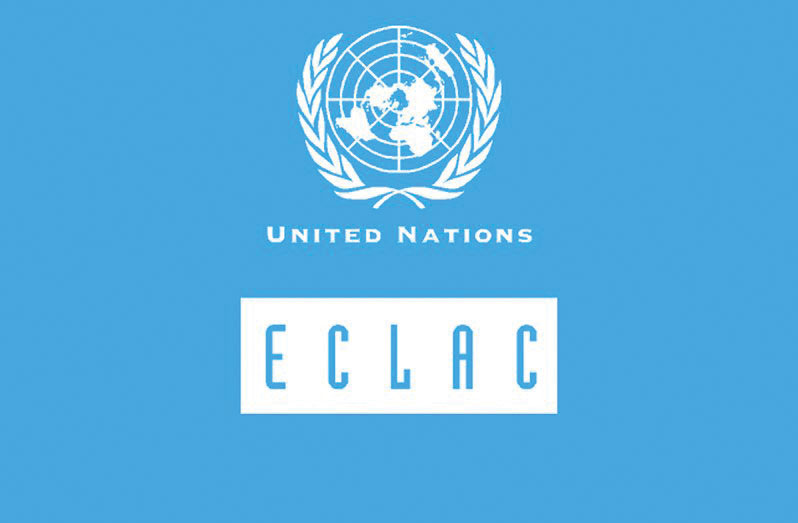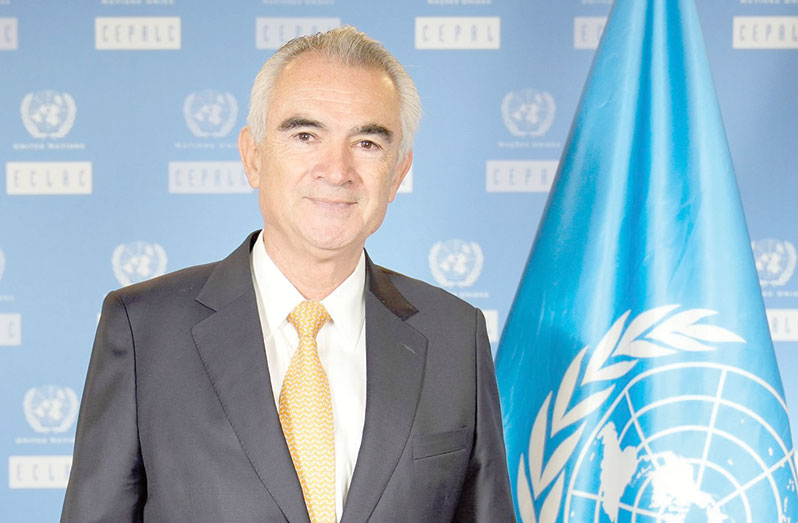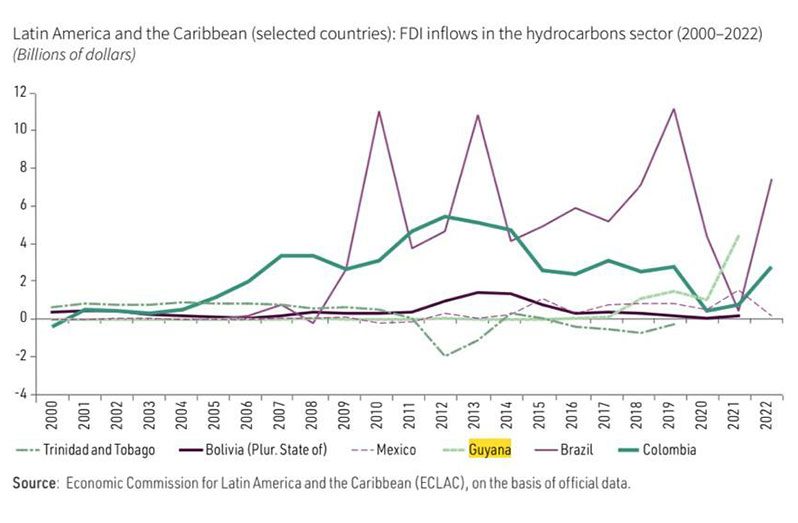–ECLAC report reveals; says country will consolidate its position as the world’s fourth-largest offshore oil producer by 2035
–ahead of countries such as the United States, Mexico, and Norway
GUYANA has solidified its position as the leading Foreign Direct Investment (FDI) destination in the Caribbean for the second year running, according to the United Nations Economic Commission for Latin America and the Caribbean (ECLAC) 2023 report.
The report, which analysed FDI trends in the region, highlighted Guyana’s impressive growth and its pivotal role in attracting investments.
According to the ECLAC report, Latin America and the Caribbean experienced a surge in FDI in 2022, reaching a record-breaking value of $224.579 billion dollars. This figure represents a significant increase of 55.2 per cent compared to the previous year.
“This result is mainly attributable to the increase in FDI in some countries, particularly in Brazil, to growth in all the components of FDI, especially earnings reinvestment, and to the increase in FDI in the services sector,” the report highlighted.
Guyana’s outstanding performance in FDI inflows was underscored in the report, which stated: “In Guyana, for example, FDI inflows driven by the hydrocarbons sector grew by 116 per cent in 2021 relative to the previous year’s level, representing 65 per cent of GDP.”
The report also highlighted the impact of major investment projects, mentioning: “Six investment projects in Guyana were announced in 2022, including an oil exploration project announced by the United States company, ExxonMobil, for US$10 billion.”
To give an idea of the size of these projects with respect to the country’s economy, in 2021 Guyana had a GDP of US$6.816 billion and a population of roughly 800,000. Two energy sectors —coal, oil and gas and renewable energy— became more important in 2022 owing to higher global energy prices, and also to the ongoing energy transition efforts.

The growth in coal, oil and gas mainly came from large projects announced in Guyana and Mexico, which together totalled over US$22 billion and accounted for 93 per cent of the total for projects in the sector.
The renewable energy sector ranked third, with an amount close to US$11 billion and 40 per cent growth on the previous year. However, the sector remains well below the levels seen in 2019, when renewable energy projects totalled more than US$20 billion.
The shift in investment trends was a notable finding in the report.
It stated: “Between 2010 and 2021, the amounts announced in renewable energy projects in Latin America and the Caribbean outstripped those of non-renewables, with the latter’s share dwindling from 24 per cent of total announcements in 2005 to just 5 per cent in 2021.”
However, the report highlighted a change in 2022, stating: “Nonetheless, an increase in the number of announcements of oil, gas and coal projects in the region in 2022, driven by a large project in Guyana, meant that this total outweighed that of renewable energy announcements for the first time in over 10 years. As a result, the non-renewables sector remains a leading sector in terms of future investment prospects in the region.”
Regarding Guyana’s position as the primary recipient of FDI inflows in the Caribbean, the report noted: “Once again, in the Caribbean, Guyana recorded the highest FDI inflows, which totalled US$4.389 billion in 2022. The result is similar to the record inflows in 2021 (only a -1.5 per cent change).”
It further explained that foreign investors’ interest in Guyana’s hydrocarbon sector played a significant role, stating: “Hence, the natural resources sector accounted for 99 per cent of FDI inflows into the country in 2022, although inflows into the sector were two per cent lower than in 2021.”
CONSOLIDATING ITS POSITION
The report projected a promising future for Guyana’s hydrocarbon sector, noting: “Projections indicate that Guyana will consolidate its position as the world’s fourth-largest offshore oil producer by 2035, ahead of countries such as the United States, Mexico, and Norway.”
It also emphasised the economic importance of oil production for Guyana, adding: “Royalties and tax revenues from exploration of the resource are projected to total US$13 billion by 2029.”
According to the ECLAC report, FDI inflows to Latin American and Caribbean countries had not topped $200 billion dollars since 2013. These flows also increased as a share of regional GDP in 2022, accounting for 4.0 per cent, the document states.
“The challenge of attracting and retaining FDI that contributes effectively to the region’s sustainable and inclusive productive development is more relevant than ever. There are new opportunities in an era of reconfiguration of global value chains and geographic relocation of production in the face of a changing globalisation,” ECLAC’s Executive Secretary, José Manuel Salazar-Xirinachs said during the presentation of the study’s main conclusions during a press conference in Santiago, Chile.
The senior official emphasised: “The challenge is not only to attract and retain, but also to maximize FDI’s contribution to development, and to this end countries must focus on post-establishment productive development policies, which include the promotion of productive linkages, policies for adding value and moving up value chains, for human resources development, infrastructure and logistics, and building local capacities.”

The ECLAC official said that FDI can play a critical role in accelerating the energy transition, facilitating technology transfer and enabling emerging technologies.
He added that governments must lead the coordination of strategies for the energy transition’s success in the region, the Commission underscores.
“They are responsible for making sure that non-renewable energy activities are reduced radically, as required by the climate commitments, while managing to mitigate their negative effects and their economic and social costs, especially in terms of investments, employment and income.
“One of their central functions is to develop long-term policies that promote investments in renewable energy sources, so that the transition is rapid and secure, and does not leave the region lagging behind in a context in which energy from clean sources is a factor of competition,” the study revealed.
Since the discovery of oil, Guyana has attracted significant attention from the international community and government is harnessing this interest to showcase the country’s capabilities of addressing pressing global challenges.
President, Dr. Irfaan Ali has said that Guyana’s intention is to leverage its oil discoveries to foster strong global leadership in these critical areas. Of particular importance is Guyana’s commitment to forest conservation and its role in combating climate change.
He highlighted a historic deal in which Guyana will earn a minimum of US$750 million from the sale of internationally certified carbon credits to the Hess Corporation over the next decade, with at least 15 per cent of the funds being reinvested in indigenous communities.
As part of this commitment, the government, in December 2021, introduced the Local Content Act. The law identifies 40 sectors or services, and requires oil firms and their subcontractors to purchase a minimum percentage of their total expenditure on those services from Guyanese vendors.
As a result, the Act creates an enabling environment for the growth and expansion of Guyanese businesses, as well as business and job opportunities for Guyanese nationals. The LCA is expected to be updated soon.



.jpg)









